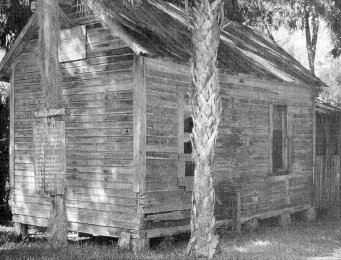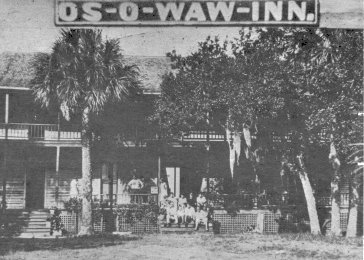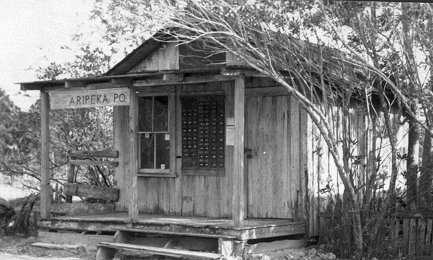HISTORY OF PASCO COUNTYAripeka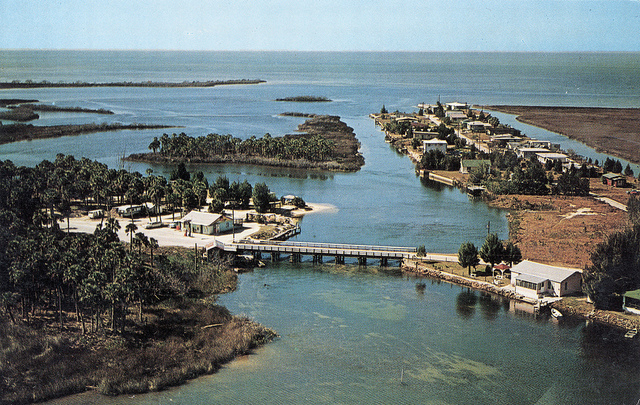 This page was last revised on Feb. 16, 2020. Dec. 7, 1859. Maj. John Parsons and Nannie Yulee receive a deed for property in S1-T24-R16, in what would become Aripeka. 1866. Sam Jones, a Mikasuki chief also known as Aripeka, dies. [Wilfred T. Neill believed that he lived about seven miles north of the town that bears his name.] 1873. Gulf Key is settled, according to the Florida State Gazetteer. Oct. 9, 1883. The Gulf Key post office is established. 1885. A publication reports Gulf Key is a regular stopping place for the new steamer “Gov. Safford,” and its shipping consists of two sloops, one schooner, and numerous smaller craft, running between this port, Yellow Bluff, and Cedar Keys. Population: about 32. James Arnold is the postmaster. 1886. George W. C. Littell and his wife Amanda settle here. They came to Florida hoping the climate would improve the health of their son Weaver. Nov. 12, 1886. The Gulf Key post office is renamed Argo. [In 2017 Carl Norfleet wrote, “Argo was about a mile in from the coast and barely into Hernando County.”] 1886-87. A publication shows Gulf Key with a population of 50. The postmaster is J. H. Pinkerton. The town has a school, one store, and a machine shop. Residents listed are Miss Dora Agincourt, a teacher; A. Corpitt, a painter; J. G. Guthrie, a physician; F. F. or F. T. Kuhns, a machinist; M. G. Lewis, a carpenter, A. B. Paxton, a photographer; R. G. Pine, a photographer; James Arnold; A. Cupitt; A. T. Howell; P. L. Pinkerton; C. Stevenson; S. C. Carleton; and M. D. Fallman or Fillman. Jan. 15, 1887. The Pensacolian reports, “The postoffice at Gulf Key has changed its name to Argo. Those that are interested in this beautiful and thriving town on the gulf will please take notice.” Dec. 3, 1888. School board minutes show Argo School with 19 students enrolled. Aug. 8, 1889. J. G. Guthrie is appointed the teacher at the Argo School. Sept. 28, 1889. A deed transfers property in S6-T24-R17 from J. H. Pinkerton and Annie E. Pinkerton to the school board. Dec. 24, 1892. The Argo post office is renamed Gulf Key. Aug. 7, 1893. George W. C. Littell is appointed as the teacher at the Argo School. Feb. 11, 1895. The Aripeka post office is established. The first postmaster was George Pine, a photographer born in New Jersey in 1835. [The first post office was on the Hernando County side, and in the early days the northern part of the town was called Aripeka and the southern part of the town was called Hammock Creek.] Jan. 6, 1896. The Gulf Key post office is discontinued. 1898. The Littell Fish Camp is built. Dec. 9, 1898. The Wheeler post office is established, with postmaster George W. C. Littell. [The post office was discontinued on May 15, 1902.] March 18, 1904. A newspaper mentions Mrs. Leonora Ellis, a resident of Aripeka, and describes her as a well-known southern writer. 1905. George Pine, who earlier lived in Aripeka for twelve years, writes, “About a dozen families from Arkansas have built homes [in Aripeka], a store and church have been added, and the place has the prospect of becoming a thriving town.” Mar. 31, 1905. A newspaper reports:
1908. John Patrick McNatt and his wife David Alice McNatt move to Aripeka. John put up a store; Mrs. McNatt was the postmistress from 1908 until she died in 1916. Their son Walter recalled there were 12 homes in Aripeka and one home in Hammock Creek. 1908. First Baptist Church is organized, according to a 1968 St. Petersburg Times article. Jan. 7, 1908. A storm destroys a fishing camp owned by Capt. John Savarese at the mouth of Hammock Creek. Oct. 11, 1908. The Tampa Morning Tribune, on a special page about Aripeka, has:
Ellis was Richard Abbey Ellis (1866-1928). Sept. 1910. The Atlanta Constitution has: Atlantan Buys An Entire TownE. G. Willingham Purchases Florida Town.Bought Everything Except the Church and School Buildings in Aripeka, Fla., for Approximately $15,000—It Is Located Directly on the Gulf.
About 1912. James B. Kolb and his wife Amanda Elizabeth move with their children to Aripeka. Mar. 24, 1916. School board minutes refer to a school at Aripeka. 1918. The 1918-1919 Florida State Gazetteer and Business Directory shows Rev. H. E. Parsons as postmaster of Aripeka and a notary. It reports the population of Aripeka is 50. Other residents listed are C. A. Brown, fisherman; D. T. Harvey, fisherman; E. G. Willingham, proprietor of the Hotel Osawa, J. B. Kolb, carpenter; J. G. Lee, truck grower; G. W. Robinson, truck grower; and Sterling Robinson, fisherman. 1921. James Kolb becomes postmaster, opening a post office on the Pasco County side, according to the recollection of his daughter. 1921. Mrs. Josephine Lynch and her husband move here and buy the Os-O-Waw Hotel. [In 1924, N. P. Lynch of Indiana arrived and purchased the only large building which he used as a hotel, according to a 1947 newspaper article. On Feb. 2, 1930, the Tampa Morning Tribune reported, “Os-O-Waw Inn, on the gulf near Aripeka, has reopened with Alf Kuhlman in charge.” On Oct. 15, 1931, the Tampa Morning Tribune reported, “Government prohibition men yesterday reported a raid on the Osa-Wa Inn at Aripeka Tuesday morning at 3 o’clock and that Louis Neeld was held for investigation.” A 1948 newspaper shows N. P. Lynch and Mrs. Lynch in front of the Os-O-Waw Inn and reports they are getting too old for the business and would like to get out. A classified ad in the St. Petersburg Times on Jan. 23, 1949, reads: “SMALL HOTEL, or fishing lodge, two cabins, right on water. $17,000; one half down payments, bal. terms. Owner in ill health. Call in per. Do not write. OS-O-WAW Inn. N. P. Lynch. Aripeka, Hernando Co. Fla.” In 1956, Mrs. Lynch sold the hotel to Raymond Frisch from Ohio. He operated it as a lodging house and fishing camp. In a 2009 email, his granddaughter Dianna Frisch recalled, “As I was growing up I remember spending many a day roaming the hallways of the Inn and playing in the rooms, since it was no longer used as a hotel.” In 1959 Brooksville businessman Henry Holloway purchased the Os-O-Waw Inn, planning to convert it into a high class sportsman’s lodge and dining room. On Aug. 28, 1960, an advertisement offering the Osowaw Inn for sale appeared in the Cleveland Plain Dealer. It has 17 (?) rooms, lobby, dining for 200. Price: $35,000. According to a source, the Osowaw Inn burned in 1960. A Feb. 1961 newspaper article included a picture of the hotel with the caption: “Legendary Os-O-Waw Inn in Aripeka has been remodeled and the room in which baseball’s mighty Babe Ruth once slept is now the kitchen.” In a 1971 interview, Mrs. Josephine Lynch recalled, “Some kids set it afire about five years ago.”] May 1, 1922. School board minutes indicate that Harvey and Cobb of Aripeka offered to furnish lumber for a school in return for tuition for county line pupils. Minutes of Aug. 21, 1922, indicate the board agreed to pay its pro-rata share for conducting a school at Aripeka. Oct. 1923. At a meeting of the Hudson-Aripeka Board of Trade, J. C. Mitcham and J. B. Kolb report on attempts to have telephone lines extended from Hudson to Aripeka. May 8, 1928. The Dade City Banner refers to “the new and beautiful Baptist church at Aripeka.” Oct. 13, 1931. Prohibition agents raid the Ossa-Wa Inn at 3 a.m. Louis Neeld is held for investigation. Aug. 28, 1933. An order is issued to close the Aripeka post office. [The order was rescinded after a petition was signed by 69 patrons of the office.] 1945. Postmaster James B. Kolb dies. His daughter Lizzie Bell Jackson becomes postmaster (until 1974). She later recalled there were 50 or so people living in Aripeka in 1945, and only eight or ten boxes. Oct. 3, 1947. The New Port Richey Press reports that electricity has been brought to Aripeka as an REA project, but that residents still await telephone service. Oct. 8, 1950. The New Port Richey Press reports: “Friday was a ‘red letter’ day for the residents of Aripeka, after two years of struggle we received the telephone lines.” 1960. A community club building is constructed on property donated in 1959 by C. E. Hines. 1962. A new post office is built. [It was expanded in 1983.] 1976. The noted artist James Rosenquist builds a house and studio in Aripeka. 1981. Margaret Pras becomes the postmaster. Jan. 9, 1988. Singer Anita Bryant performs at the Elks Lodge of Aripeka, ending a decade-long hiatus from show business. 1989. Landscape artist Leslie Neumann moves to Aripeka. Mar. 13, 1993. Flooding from the “No-Name Storm” causes extensive damage in Aripeka. Apr. 26, 2009. The home, office, and studio of painter James Rosenquist are destroyed in an 80-acre brush fire. July 4, 2015. SunWest Park opens to the public.
Edward George Willingham (1839-1922)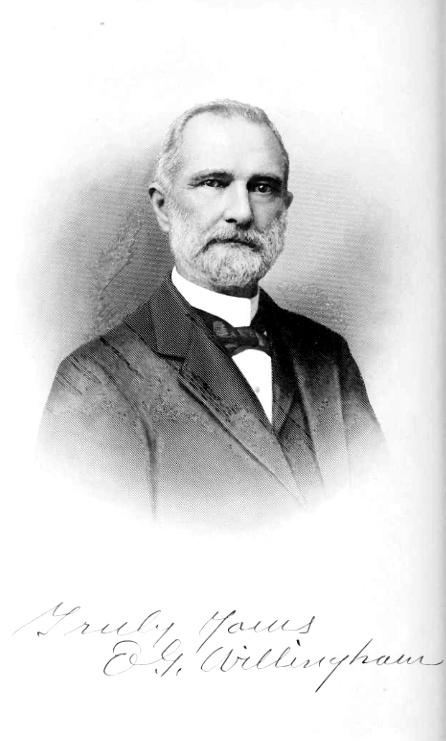 The following is excerpted from Baptist Biography (1920), vol. II, edited by B. J. W. Graham, D. D. Feeling the necessity of spending his winters in Florida and his summers in the mountains, Mr. Willingham turned his large lumber business over to his sons, E. M., Joseph A. and Eugene D. Willingham. After visiting every section of Florida and traveling over the island of Cuba, Mr. Willingham finally visited Aripeka, on the western coast. The only way by which he could reach the place was by boat. The impression it made upon him was so unfavorable he decided to leave the next day. But Aripeka soon won his affection, and for a number of years he has made it his winter home. In the settlement of Aripeka, building lots were sold from a large tract of land while the land as a whole was under a mortgage. This mortgage was foreclosed, and the entire town was sold and was bought by Mr. Willingham. Generously he gave a deed to each party who had bought lots. On this property is a beautiful island, on which Mr. Willingham has erected a modern residence, with every convenience, including a complete system of sewerage and waterworks. Largely through his influence a magnificent highway has been constructed from Brooksville, through Aripeka, to Tarpon Springs, and Tampa. The island on which Mr. Willingham now spends his winters is befittingly called Eden, because it is a beautiful garden of tropical flowers and fruits. The active life which Mr. Willingham has lived has made it impossible for him to be idle. In Aripeka he has cleared and developed quite a large area of land on which he grows various kinds of farm products, fruits, nuts, etc. … In Aripeka, where he now lives, he has erected a beautiful house of worship and secured the services of a good preacher and a tactful pastor, who devotes his entire time to the church. Zita Ballinger Fletcher provided the above image.
Recollection of Walter I. McNattThe following oral history by Walter I. McNatt is taken from Florida Cracker Days in West Pasco County 1830-1982. I was born January 3, 1898, about twelve miles west of Dade City. Our closest neighbor was about a mile away. In 1908, we moved to Aripeka, a small town of twelve homes. The families in town were White, Mathews, Robinson, Johnson, Jetter, Lee, Barnett, Ellis, Johnson, Kolb and Harvey. My father put up a store, and we had to go to Hudson to pick up supplies shipped on the B&H train from Brooksville. The B&H initials honored the two towns. The train traveled through Enville, which is now Masaryktown, where a turpentine still was located. It passed Sagano, site of another turpentine still. In Pasco, at that time, there was only one house in Hammock Creek. It was owned by Pearl Littell. There were three houses on the way to Hudson. One was occupied by Charley and Gene Carter and their parents. Aunt Jane Ryals lived in one, and Olen and Hattie Hay lived in the other house. My mother, Mrs. David (Alice) McNatt, who was postmistress in Aripeka, died in 1915. She originally obtained the post in 1908 and served until her death. Henry Dingus carried the mail from Aripeka to Hudson on a horse. After my mother died, Bertha Kolb, who succeeded her, moved from Aripeka to Hammock Creek, and the post office moved with her. Aripeka NewsThis article appeared in the New Port Richey Press on Aug. 19, 1927. HELEN LITTELL, Reporter Quite a few are enjoying the bathing here this season. Among them are the Cappleman families of Brooksville. Some of them have rooms at D. T. Harveys, while others are staying at the Abanatha cottage. Mr. Causner is having this home here attractively remodeled. Mrs. McBee is expecting her parents, Dr. and Mrs. McConnel, of Atlanta, for a short stay. Miss Catherine Harvey has returned to her home in Tampa, after visiting a while with her brother, D. T. Harvey and family. Mr. and Mrs. Henry E. Norfleet and infant daughter of Elfers spent last week end at the home of J. B. Kolb. Brax Graham, formerly of Aripeka, is visiting friends here. We are glad that the road from Brooksville to Aripeka is about completed. The grounds for the new Aripeka Baptist church are being cleared. The church building will be erected soon. Miss Hoab and brother of Dade City are spending a few days here. Tom Alexander and sons Tom and Chester are returning to their home in Dade City after having completed their work here. Jack Wardlaw has returned to Tampa, after spending a delightful vacation at the home of C. P. Littell Monday. Friends of Charlie Carter will be glad to learn that he is improving after having been in the hospital. C. P. Littell is constructing a large boat, which he expects to use in his fish and sponge business. Mr. and Mrs. Skirmer and children of Tampa are staying at the Willingham place for the summer. G. W. C. Littell is a business visitor in Tampa this week. Miss Mildred Palmer of Elfers was a dinner guest of Ina Littell last Sunday. Miss Bertha Kolb has returned to her home here after attending summer school in Gainesville. Mr. and Mrs. W. A. Conner are the proud parents of a baby boy. Aripeka NewsThis article appeared in the New Port Richey Press on Aug. 26, 1927. HELEN LITTELL, Reporter Some excitement in Aripeka, a real honest to goodness bear hunt for a real honest to goodness bear. Some of the stock men found the tracks of two large bear a few miles from here, and a large hog killed and partly eaten by them, so they secured some dogs, and every one turned out on the bear hunt the next morning. However, the rain came down and saved the bear. Miss Evelyn Harvey is spending a few weeks in Tampa. Joseph Guthrie and sister Doris of Miami visited with G. W. C. and C. P. Littell’s family a few days last week. Dr. and Mrs. C. F. McConnel of Atlanta, and Mrs. Coella McConnel and three children of Tifton, Georgia, have returned to their homes after a delightful week with Mrs. Myrtle McBee. Mr. and Mrs. J. B. Kolb made a trip to Plant City this week on official business. Ina and Madeline Littell were dinner guests of Mrs. McBee Sunday and attended church service at Hudson in the afternoon with Mrs. McBee. Raymond McNatte’s family of Dade City were down for Saturday, bathing and fishing. Malery Snow’s family of Brooksville are stopping at the Van View for the week. The John and Henry Grant families enjoyed a fish fry here Saturday night. Quite a number of the young folks of Hudson and Aripeka met at Edith and Helen Littell’s last Wednesday evening and spent an enjoyable evening playing games and making candy. Elmo Gant spent the week end with Bartow Littell. Mrs. J. B. Kolb is visiting in Tampa this week. Mr. and Mrs. Skirmer and children spent Saturday in Tampa. Mr. T. D. Cosner is building an addition to his boat house. Up and Coming AripekaThe following article appeared in the St. Petersburg Evening Independent, about Oct. 1947. This little town of 125 persons is on the way up—fast. Lying 15 miles to the north of New Port Richey two miles west of the West Coast highway, it straddles two counties, Pasco and Hernando. The “fertilizer” which started the rapid growth was electrification which began in the summer of 1941 and was recently completed by the Rural Electrification authority. Prior to that time the community, not so long ago having only seven families, has depended upon kerosene lamps and candles. On the strength of having electric power, Aripeka has grown by leaps and bounds, bringing in families from Virginia, West Virginia, and Kentucky, and some from other states—All the homes, except two, are now enjoying this much needed improvement since the ‘juice’ was turned on a few weeks ago. No one there wants to go back to the old days of kerosene lamps and candles since the power of electricity has come to brighten their homes. The telephone is being talked about but is a thing of the future, no telling how many years hence. As yet, no city water is available there and it is not known when this improvement will be made. The late John B. Kolb, whose family still resides in Aripeka, and his son-in-law, Henry Norfleet, now of New Port Richey, dug the first and only well in that vicinity about 20 years ago. They picked a place which they thought would be a good spot for a well, near a pecan tree on the Kolb property, and began digging with a post hole digger. Before they got very far down the instrument struck rock, then they began to use a hand drill and went down to a depth of 98 feet. At first the water was salty but as the drill went deeper the water became better. This well is still being used by many families as their only means of water supply, while a number of other families are catching rain water for cooking, washing, and other purposes. In 1924, N. P. Lynch of Indiana arrived there and purchased the only large building which he has been using as a hotel, known as the “Osowa Inn” which overlooks the Gulf of Mexico. Fishing is the main sport at Aripeka for the inhabitants and winter visitors, with virtually no commercial fishing. As one man stated, Aripeka might be called a “Pensioner’s Paradise” for those that have come from various parts of the country to make their home there look for nothing better than to live comfortably, fish for recreation, bask in the sunshine, and enjoy the quietness of a small southern community on the Gulf of Mexico, far from the noise and hub-bub of a large city. 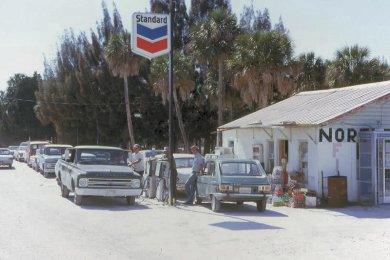 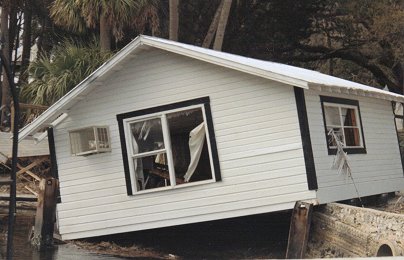 A Community EffortThis article appeared in the New Port Richey Press on July 20, 1961. By C. P. KIDD Over 30 years ago this spring, seven residents of the Aripeka area organized the Aripeka Sewing club, the group including Mmes. W. Smith, C. P. Kidd, J. R. Bryant, W. D. Coney, F. D. Cosner, Sam D. Rothell and Esther Littell. The ladies met weekly about three months of the year, or during the tourist season. As the community grew, membership increased to about 20 in 1945, when the organization had in reality developed into a social club, since some of the group preferred games and conversation to sewing. In 1951 it was decided to reorganize. The name “Variety Club” was selected as most appropriate and Mrs. Kidd was elected chairman. The Variety Club grew and continued to function as the main social outlet of the community until Mr. and Mrs. P. M. Deitz came to Minnow Creek. This civic-minded couple immediately joined the club and later proposed an expanded program of activity. On Feb. 6, 1953, Mrs. Deitz mailed a postal card to every woman receiving mail at the Aripeka post office, with the following notation: “You are invited to attend a meeting to be held Feb. 11 at the Smith store, for the purpose of organizing a community club.” Thus, the Aripeka Community Club came into being, with Mrs. W. T. Morgan being named president. Library, publicity, refreshments, entertainment, planning and hobby show committees were named and the club was in business. The “Library Station” which was opened in the community hall a short time later was the only library of this nature in the state. It was a branch of the F. E. Lykes Memorial Library in Brooksville, of which Miss Rosalie Norris was librarian at the time. Miss Norris would load her car with books and take them to Aripeka, hauling back the ones she had delivered the previous month. This library was kept open two afternoons each week for a number of years, or until television began to take its toll. In addition to organizing the new Community Club, Mrs. Deitz donated five dozen place settings of stainless steel tableware and was instrumental in securing 25 chairs. She and Forrest Gooding also took the lead in purchasing a piano and 30 hymnals, with the help of other members. E. W. Reichardt was elected the president of the club in 1955. A board of five directors also was named and the organization was granted a charter, following which by-laws were adopted in March, 1955. Arrangements were made with the Withlacoochee River Electric Co-op in Dade City for installation of street lights in 1955, and a committee was appointed to make plans for a new community clubhouse. Although C. E. Hines offered to donate a lot for this project, it was not until 1959 that the definite action was taken along this line. In the meantime, Ed. Smith served as club president in 1956-57, Fred Bautz in 1958 and W. Ralph King was elected to head the group in 1959. In response to a request by Mr. Hines that final action be taken on his offer of a lot, a meeting was called and a decision reached to accept his proposition. Donations and pledges were made toward a new clubhouse at this meeting and Club Treasurer D. O. Coon was delegated to canvass the community for additional funds. A date was set for clearing the half-acre plot and some 20 men and several women showed up with hoes, rakes, saws, axes, etc., to complete this portion of the project in short order. In general, the canvassing committee found ready response to the appeal for funds. Additional money was raised by such projects as fish fries and chili suppers, so that by early this year the treasury warranted actual start of construction. Facilitated by donations of materials and labor, building operations progressed rapidly with the result that on Sunday, Mar. 13, Aripekans proudly dedicated the fine 34×54 clubhouse, made possible by the concerted efforts of the entire community. Taking the lead in bringing the dream to realization was a committee having as its members D. C. Koon, chairman; J. C. Girton, Community Club president; W. R. King, Wm. D. McIlrath, Bob Girton and Geo. Martin. 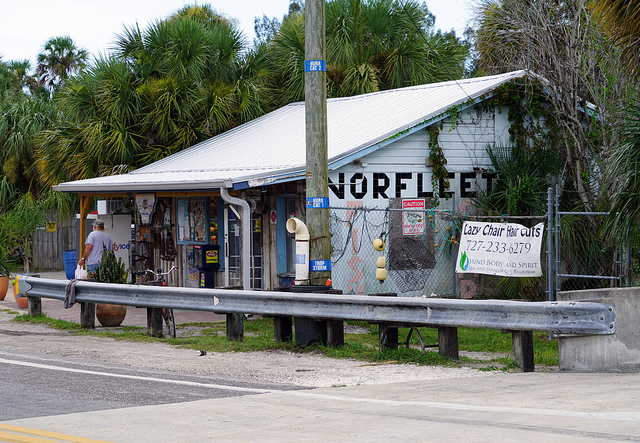 Babe Ruth in AripekaIn Tales of West Pasco (1962), Ralph Bellwood wrote:
A Tampa Tribune article on Sept. 30, 1991, has:
In a Feb. 28, 1971, St. Petersburg Times article, Mrs. Josephine Lynch showed a reporter a picture of the Os-O-Waw Hotel, which she and her husband owned, and identified Babe Ruth in the picture. Mrs. Lynch is quoted, “He used to come here all the time, just to rest.” On Feb. 25, 1932, the Brooksville Journal reported that Babe Ruth was in town last Friday, stopping for several minutes at the Amstutz Garage for gas and oil. According to Old Brooksville in Photos and Stories, Ruth liked the fishing at Aripeka, Bayport, and Homosassa. On Sept. 6, 1954, the St. Petersburg Times reported, “In 1925, 1926 and 1927 the great Babe — and frequently a large part of his team — visited at the Oso-Wah Inn. Almost anyone who was living in Aripeka during those years has a tale or two to spin about the Home Runn King.” 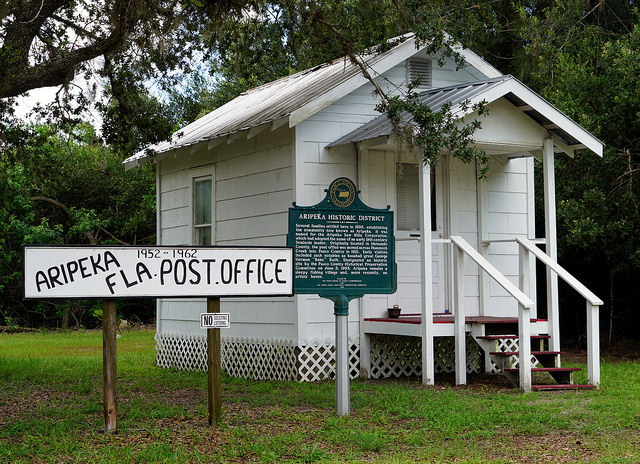 Aripeka Recalls the Florida of an Earlier DayThis article appeared in the St. Petersburg Times on May 17, 1987. By FRANCES LEE GARRISON ARIPEKA – To visit Aripeka, a few miles north of Hudson, is to step back in time. This tiny fishing village, which straddles the Pasco-Hernando County Line on the coast, has many claims to fame, the most astonishing of which may be that it has changed little since its early days. Oh, it has electricity and telephones and running water and the residents drive cars, not horse and wagon rigs. But the little houses are simple and unpainted, with windows open to catch any passing breezes. At the little park by the Norfleet fish camp store by the Hammock Creek bridge, a large sign sets the tone of the place as you read the following words: “No alcoholic beverages, except what’s sold in store. Watch your mouth and respect others so families and everyone can enjoy the park more. No open fires and no profanity.” As you cross the first Aripeka bridge coming northwest from U.S. 19 on Old Dixie Highway (CR 595), you notice a little time-weathered wooden cabin where a large board sign in the yard proclaims that in 1919 Babe Ruth fished here and that Jack Dempsey trained here in 1921. They also played poker together, according to the sign. Actually, according to Lizzie Bell Jackson, former postmistress who has lived in Aripeka longer than any other resident (since 1911) the real Babe Ruth cabin was originally near the Os-O-Waw Hotel, which burned in 1960. That little cabin is now on the Robbins property across from the parsonage of the Aripeka Baptist Church. Mrs. Jackson confirms that Babe Ruth came to Aripeka for fishing and stayed in that cabin. In addition to “the Babe” and Jack Dempsey, Aripeka—which was first called “Wheeler”—claims at least a passing acquaintance with Ponce de Leon in 1513, Hernando de Soto in 1539, legislator Corwin Pearl Littell and aviators Orville and Wilbur Wright. A large hand-lettered sign in the yard where the second Babe Ruth cabin stands lists all those famous people and tells you that, “It was here, (in Aripeka) in the 1880s that the coastal steamer Gov. Stafford took on freight and passengers, and where the village fishermen have always cast fate and soul to the mercy or rath (wrath) of the Sea.” Adjacent to the second Babe Ruth cabin are some other old buildings shadowed by tall fir trees and palms. Facing the inlet on the Gulf of Mexico is a large house with wide porches that Mrs. Jackson said her daddy, J.B. Kolb, built long ago of long-lasting “heart pine.” Other old buildings near the house are labeled “Aripeka General Store 1918 and a blacksmith shop of the 1920s.” While these may be typical of those early times in Aripeka, it is not certain they are authentic. These buildings stand in the county of Hernando. Pasco County, which was carved out of southern Hernando in 1887, starts at the bridge by the second Babe Ruth cabin. A small portion of that property is in Pasco. The U.S. Post Office in Pasco is on the original site of the post office opened in 1921 by Kolb. Mrs. Jackson says the very first post office was about 1 1/2 miles from the present one. It was being closed by the government, but Kolb said if the government would keep a post office in Aripeka he would operate it. Her father operated it until he died in 1945, when Mrs. Jackson became postmistress. She retired in 1974. This tiny town of yesterday is said to be named for Chief Aripeka of the Seminole Indians. The legend on the sign listing famous people of Aripeka calls Chief Aripeka “most fierce and skillful warrior in military history who, at over 100 years of age led his proud and never defeated Mikasuka warriors into many battles from here to the Everglades vs. U.S. aggression.” In “History of Broward Co.,” it is said that in 1858 when the U.S. government gave up trying to defeat Aripeka, who had holed up in the Everglades, the Indian chief was down to just 12 warriors. In “The Story of Florida’s Seminole Indians” by Wilfred T. Neill, the Indian’s name is spelled Aripeka. He also was known as Sam Jones and his settlement deep in Big Cypress Swamp was called “Sam Jones Old Town,” according to Neill. Aripeka Baptist Church Celebrates 100 Years (2010)This article appeared in the St. Petersburg Times on Nov. 20, 2010. By MINDY RUBENSTEIN ARIPEKA — The “friendly little church by the sea” lives up to its reputation. “You’re a visitor the first time; after that you’re considered home folks,” said Pastor Joe Simms in his soft, Southern accent. “That’s just the spirit of the church. Not only friendship but ‘familyship.’ ” Aripeka Baptist Church celebrates its 100th anniversary as a congregation this weekend. The small white church sits tucked away in a fishing village on the west coast of Pasco County, north of Hudson. And while many things have changed over the years, one thing has remained constant: The old-fashioned church is the hub of the close-knit community. But people now come from all over to share in its charm. “You don’t choose your family, but your spiritual family you do choose, and we really are a family,” said Simms, who is in his sixth year at the church. “We worship together and have outreach in the community, doing what’s right, and right is according to the word of God.” Louise Geiger, the unofficial historian of Aripeka, jokes that she fills that role because no one else wants to. “I’ve been a member longer than anyone else,” she said. “I went to church there before I was born.” Her grandfather James Kolb, or Papa Kolb, donated the land and helped build the original church on the front of the lot. That building is now the fellowship hall. A fire a couple years later destroyed the church, so he rebuilt it exactly like the one that burned, Geiger said. She has pictures and documents she’s collected over the years, which she keeps at her house, just off the main road. For now, the Aripeka folks run their own post office, and everyone in town knows each other. The church attracts people from the surrounding communities, including Hernando Beach, Spring Hill, and even Port Richey. But the “old-timers” serve as the matriarchs of the town and the church. “It’s taken on different personalities,” Geiger said. It was once a plain building with just a front door. Then they closed in the porch and added another porch with a walkway, and then added the steeple. The church sees bigger crowds now. While they used to have just 14 members, they now have more than 100. Her mother and aunt both went there until they died, as well as her aunt’s family and her seven children, who are still in the community. “I don’t miss a service, period, unless I’m sick,” Geiger said, including Wednesday prayer meetings, Sunday school, and preaching Sunday morning and evening. Geiger’s cousin Verna Sloan just celebrated her 70th birthday and boasts that she also hasn’t missed a service. “I told everybody I was born on Sunday and that’s probably the only day I missed going to church,” she said. “I’ve been going there all my life. It’s a very, very friendly church and everybody helps each other. I’ve been to some bigger churches that were not as friendly.” When Sloan found out she had cancer, she learned just how much the church and the community mean to her. She has been getting chemotherapy treatments and now wears a hat. On Sundays after church she goes with her friends for lunch, then they take walks along the marsh, go shopping, and come back for services that night. “That’s when it’s nice to have a small church because they all rally around you,” she said. “I love those people. … They’re my second family.” Some of her family members moved away, but they all retired back to Aripeka. She has seven siblings in the area. Geiger is her “double first cousin” — two brothers married two sisters. “A lot of the town people will come and then just keep coming,” Sloan said. “People out of Spring Hill like to come to a small church.” And the close-knit community welcomes them. Sloan explains one of the practical reasons Aripeka hasn’t changed over the years: You cannot build on marsh grass. And since the Gulf of Mexico is on one side, and marsh grass is on the other, that doesn’t leave much room for development. “There’s very little, if anything, left to sell here,” she said. Carol White, 63, recalls the days of outhouses and no electricity. “There’s a lot of changes,” said White, who is Sloan’s sister. “A lot of people have come and gone,” but “it’s still a small country church.” She remembers walking to church and Sunday school as a kid. Her children and grandchildren also went there. “Everybody knows you and everybody goes to the church,” she said. “It’s what we’ve always known and what we’ll always know.” Pastor Simms is hoping for a big turnout this weekend, including regulars and newcomers to Aripeka Baptist Church who want to cross the bridge for some Southern hospitality and old-Florida charm. “As I tell everyone, we still ring the bell for Sunday school. It’s a throwback to the way things used to be,” he said. “We believe the old ways are the best ways.” Contact Mindy Rubenstein at mindy.rubenstein@yahoo.com. The Surls Family in AripekaBy ARNO SURLS WEBSTER As the economy improved after the depression, life was good in small-town Lacoochee. We moved back to the Cummer’s quarters when the sawmill reopened and after we’d saved a little, built a house at ‘Sugar Hill’ (Surls Hill – now Harris Hill) near Trilby and moved there. Commerce improved and though families began to have some discretionary cash, there were many opportunities for good times that didn’t cost very much. Swimming at Morgan’s Ford on the Withlacoochee River was a favorite for many who lived in and around Lacoochee and Trilby. Some of you may remember the dirt road near the post office in ‘downtown’ Lacoochee, which ran north about a mile to Morgan’s Ford. Though alligators were prevalent, more then than now, we never gave much thought to them. The clear, tea-colored water was cool and delicious and we had laugh-out-loud fun there. Picture #1 below is of my father, Bill Surls, and his brother, “Doc” Surls, having fun together on the rope swing. Mama, Helen Surls, had recently bought Daddy a fashionable bathing suit, but at first he would not wear it without his summer union suit on underneath – with the funny results you see in the picture. Picture #2 is of Mary Barrs Mims and Perry Mims enjoying each other’s company on the river; notice the pretty cypress and sandy riverbank in the background. Like many Lacoochee families, we also spent holidays and some weekends on the Gulf coast at Aripeka, camping, fishing, swimming and hunting. For those of you who aren’t familiar with Aripeka, it is a little community that straddles the Pasco-Hernando county line and Hammock Creek, 40 miles west of Lacoochee, right on the Gulf of Mexico. In the fork of the river is an island connected to the mainland, then by a wooden bridge to the north and an iron bridge to the south. Picture #3 is of the bridge over the north fork of Hammock Creek as it was in those days. Vern Norfleet and Bill Smith had property on the island; both had stores there. Norfleet’s sold drinks, cigarettes, fishing bait and supplies; Bill Smith had a grocery store that sold flour, cornmeal and similar grocery items. Mr. Pierson rented cabins on the north shore of Hammock Creek and also had a little store that sold convenience items and Mr. Littell ran a fish house on the south fork. Just a little ways down the road to the south was the post office, run by ‘Baby Chile’ (Bertha) Norfleet, and on the south edge of town was the Baptist Church. To the west of the main island, is a small island that is a prominent feature of the view from the north bridge. Smaller islands chain up and down the coast there, but were not inhabited. The town has much the same character as it did in the days of my childhood, though now there is only one store, Norfleet’s, no fish houses, no cabins or rowboats for rent on the river and the environment has suffered; fish, crab and other wildlife have diminished substantially, stands of cabbage trees (sable palms) have died and changes in the flow of the river have created mud banks where there was formerly sandy bottomed riverbed and aquatic nursery marshes. There is a more modern post office, the old one converted to a small museum and the Baptist church remains though it has been moved; it formerly faced east, now it faces south. Aripeka is appealing now just because it has not developed, though there are signs that its sleepy fishing village days are numbered. Here is the story of how we started going to Aripeka in the first place. Each summer, we would go to Ozona, buy mullet and salt them down in a barrel to be used for fish dinners at home during the coming year. Ozona was a long way to go for fish, and on one trip, Daddy ventured out to Pine Island where, for a few seasons, we got our fish. One year, which I think was 1935, we were caught there in the edge of a hurricane. Afterward, Mr. Farmer, who lived with his wife at Pine Island, told us the story of the 1897, hurricane that brought a tidal surge and caused much devastation on the west coast of Florida, particularly on up at Cedar Key. With water already driven in by the storm, he said the storm surge came in three swells, the first one about three feet high. With no retreat back to the mainland, he and his wife got into his skiff and he tied it to a cabbage palm. The next surge was another three feet so he moved his rope up. The next surge was another three feet and at this point in the storm, he tied the skiff off to the crown of the palm. He knew that if another surge came, he would have to cut the skiff adrift, diminishing their chances for survival. But it never came. He said the water just receded like the tide going out. Well, that convinced Daddy that we needed a place to get fish that wasn’t so far out, roads then not being like they are today. So he explored the area: Bay Port, Mud River and then he found the little community of Aripeka. It was perfect for us; we could get our fish, primitive camp or rent a cabin, there were a few little stores and a beautiful place to swim while still being able to retreat to the mainland if a bad storm came up. There was no Doppler radar then; storms approached without any warning and few people could accurately anticipate approaching storms by the combinations of types of clouds, direction and character of the wind, patterns of squalls. We met Mr. Pierson and rented his ‘big’ cabin each year. There was room enough for a table where Mama used a two-burner kerosene stove, which made cooking easier and rainwater was available from the cistern that stood at the back of Pierson store. If the weather or bugs were too bad, we could sleep inside on pallets of homemade quilts. You had to be careful when walking about at night to keep from stepping in someone’s face because all the floor was covered with sleeping family. (Many years later, my baby daughter called a ‘pallet’ a ‘pile it’ because she thought that you just picked a spot to ‘pile’ your bed down.) To get us out of the way when we arrived at Aripeka and Mama was getting organized, she would give me and Bud a crab net, a bucket and a chicken neck tied on a string. The clear brackish river was always running in or out with the tide and teeming with fish and crabs. We would toss the chicken neck out into the river near the shore and in a few minutes, a blue crab would catch its scent, grab onto it and we would slowly pull in the string, the crab refusing to relinquish its new found dinner. We’d scoop up the crab with the net, plop it in the bucket and pitch the chicken neck out for more. What fun! In a short time, we’d have a enough for a feast. Mr. Littell would rent Daddy the use of his fish house for $5.00, and allow him to buy fish directly from the fishermen as they came in from the Gulf. In rhythm with the tides, the fishermen would dock there and unload their catch. Daddy would pay 1 cent per mullet and we could use Mr. Littell’s boxes and ice. Then we would take the fish back across the two bridges to Mr. Pierson’s store where we camped. There we set up an assembly line on the east side of the road. Bud and my Aunt Velma Surls scaled the fish and cut off the heads. Mama and Daddy split the fish and removed the roe and entrails then tossed the cleaned fish into a tub of rinse water. I washed them off and passed them to my Gramma (Elmyra) Surls who salted them and packed them into the barrel. Later, we all went back and standing around the rinse tub, cleaned the roe and gizzards; ahh, such tasty treats when fried! Every year, this process went fine, just like clockwork. Then one year, some men in Bay Port made an enormous catch of fish and sent to every little town for help. The message was, “please come and help us so we won’t lose our catch.” Now every able-bodied man wanted to help and rushed off to their aid; its what people did. Of course Daddy and Bud took off and we women had to take up the slack. We finished salting down our fish by dark but Daddy and Bud didn’t get in until after midnight: all the fish were taken care of, both theirs and ours. Picture #4 below this story is of my family at Aripeka – I am on the far right, bottom row, in front of my mother, Helen, who is in front of my brother, Bud, and my Daddy, Bill – along with aunts and uncles and cousins. We really enjoyed Aripeka in the summer. We also fished for fun and enjoyed outdoor fishfrys of mango snapper, red fish, flounder, snook, and of course, mullet. Sometimes we caught the shy sheeps head, distinguished by their black and white ‘striped convict’s suits;’ very sweet eating. Picture #5 is of my mama, Helen Surls, happy with her catch of fish, caught right there in Hammock Creek on a cane pole with cut pinfish for bait. I remember the needlefish that swam in regiments on the river’s surface that would sometimes play with sticks and seaweed. It was not unusual to watch them from the bridge, taking turns jumping over a piece of marsh grass or stick. I remember shiners teeming around the dock pilings, glinting silver in the sunlight. In those days, Mr. Norfleet rented rowboats, sold cane fishing poles and had a live well at the end of one of the docks where he kept shrimp, minnows and chubs that he sold for bait. Picture #6 is of Bud Surls in front of a cabin on one of those docks though the cabins we stayed in were at Pierson’s across the river. I don’t remember any one staying in that cabin and I believe it was just used for storage of fishing gear. Later on, though I don’t remember them but am told it’s true, Mr. Norfleet had some little rental cabins built behind his store. Throughout the day, everyone went swimming. On the western shore of the main island behind Norfleets store and Bill Smith’s store was a seawall. At that time, the canal that now forms the main channel of the north fork of Hammock Creek had not been dug, so the river circled around behind Norfleet’s store, past the back of Bill Smith’s then joined the south fork for its journey on out to the Gulf. The river between the seawall and the island to the west was sandy bottomed, deep in the middle without rocks or shell, perfect for swimming. You can see the seawall in picture #7 of me, my Gramma Surls, my father and my brother in our handsome swimming attire. That day there was a ‘spring tide,’ as you can see there was water on both sides of the seawall. Bud and I often went flounder fishing there. We would each cut a cabbage palm fond stalk and sharpen one end. Then we would ease along the shallows by the seawall looking for the outline of a flounder buried in the sand. We had to make sure it was not a sting-o-ree (sting ray) as they bury in the sand too. Then, we would jab the fish with the cabbage fond stalk, pin it to the bottom then reach down and take it by the gills and mouth and put it into our croaker bag. Now, a croaker bag is a burlap sack; some called it a ‘tow sack’ because they dragged it, some called it a ‘gunny sack’ because they used them in the military, some called it a ‘jute bag’ because of the fiber its made of, and some called it a ‘poke’ because you could poke stuff into it, but we always called it a ‘croaker bag’ because that’s what we used when we went frogging – Daddy gigged the frog, Bud pulled it off the gig and threw it in the ‘croaker bag’ that I carried. But, no matter what you called it, it was a burlap bag. Anyway, Bud and I always helped each other when we speared a flounder and it was easy for us to get enough for a flounder supper. Many of you may remember the oysters at Aripeka that, though plentiful, were not ‘eating’ oysters; we called them coon oysters. We tried to avoid them on the dock pilings and bars in the river, but everyone got cut at one time or another and all the kids in our family had scars on their fingers or feet and stories to go with them. From the bridge, we watched the sun go down in its fiery splendor then built a smudge fire of palm fronds and moss by our cabin to deter the ‘skeeters’ (mosquitos) and sand gnats of dusk. The smudge fire evolved into a bonfire and we’d sit around it picking and eating boiled crab and snacking on the remnants of our fish fry, the bright Venus setting in the west, the constellations wheeling overhead in the dark sky…… Chuck-Wills-Widow…….. Lightening bugs…… Hooting owls….. Smoke….. Hide and seek…. Late at night, we’d bed down on our pallets and in the dark, someone would tell a story or fits of giggling would ripple through the family arranged like cordwood across the floor. We’d sleep exhausted and contented sleep. At daybreak, I’d step out of the cabin and see Daddy sitting on the rail of the bridge whittling and smoking a cigarette, a black silhouette against the golden-pink of the sun coming up. We really liked this place in Aripeka, in fact, we liked it so much that Mama decided to buy it – and she did, but that’s another story. 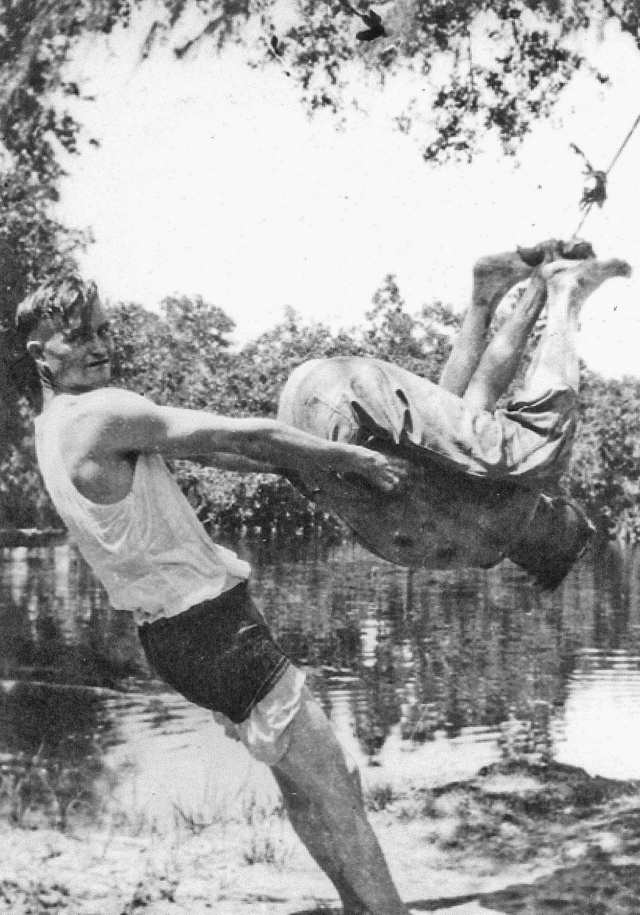 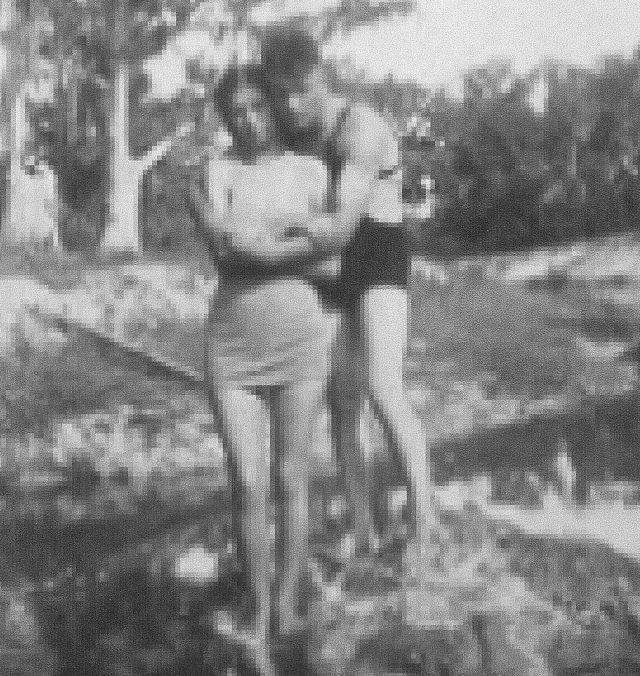 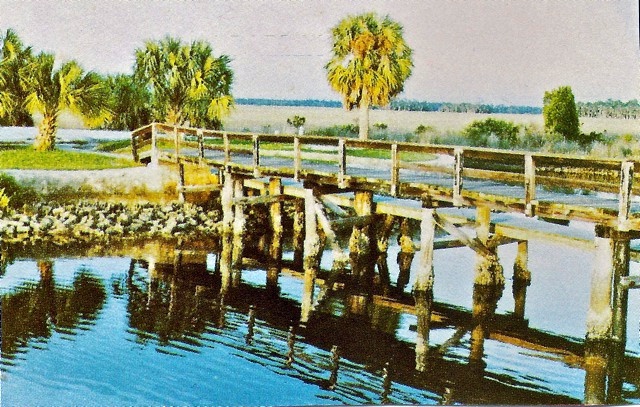 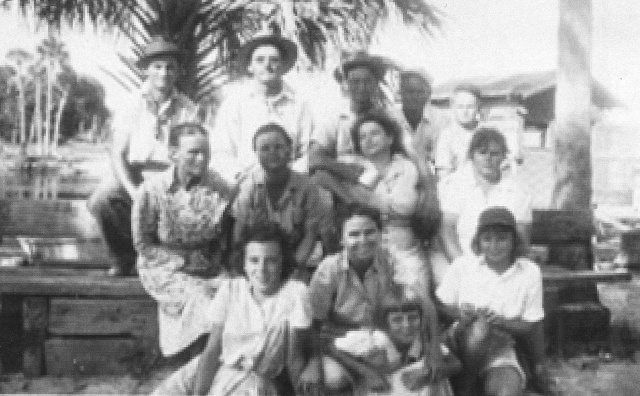 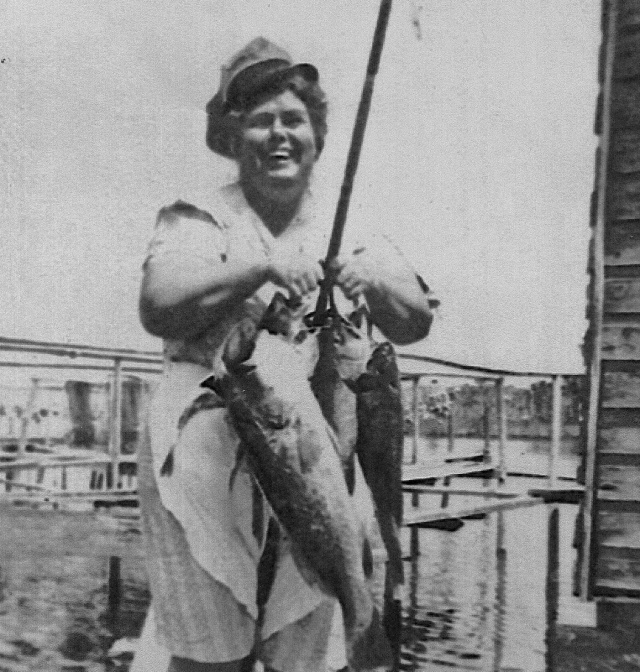 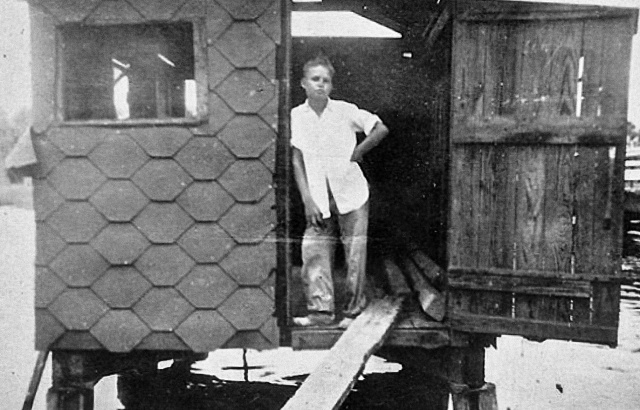 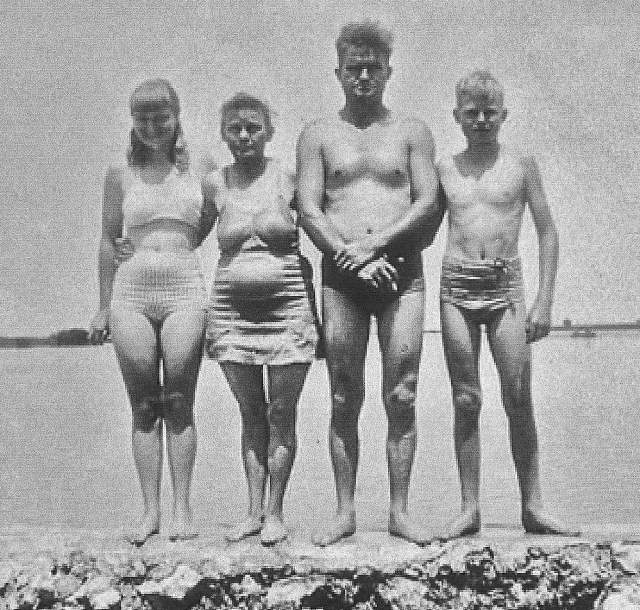 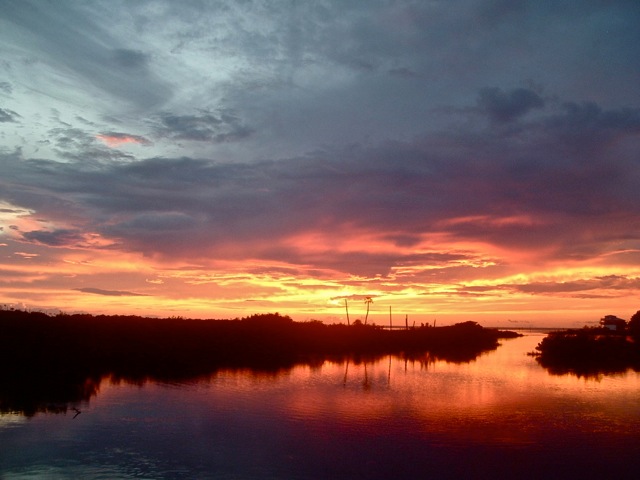 Our Aripeka Home BurnsThis article by Arno Surls Webster is taken with permission from the EPHS website. When my mama, Helen Surls, bought Mr. Pearson’s place in Aripeka, it included 12 acres of land bordered to the east by Highway 595, on the south by Hammock Creek and on the west by the Gulf of Mexico; on the north side there was a small yellow house. It also included the store, known later as the “Red Barn” which was right on the road on the east side of the property. Mama sold gasoline, kerosene, soft drinks, cigarettes, candy, crackers and chewing gum at the store. Mama sold ale and beer too, but that’s another story. Behind the store, there were four cabins; the big cabin, the little cabin, the bunk house and the other cabin – oddly enough, that’s what we called them. Mama and Daddy lived in the back of the store and rented the cabins, though they were often occupied by non-paying friends or relatives. This property I’m telling you about is on the north bank of Hammock Creek, across the river from Norfleet’s store. Lance and Sharon Sutter now own part of the property; the remainder is now State land. In 1952, my husband, Vernon Webster, and I decided to settle down in Aripeka after a few years of wanderlust; we had lived in Louisville, Kentucky; Norfolk, Virginia; and many towns in Florida renting trailer space, following road construction work: Flagler Beach, Ona, Fort Myers, Tampa, Orlando, Auburndale and Green Cove Springs. We were expecting our third child, Mark, that August. We really liked being in Aripeka, so we settled in the little yellow house: our first child, Wayne, was starting school soon so we had to stop moving about. Vernon got a construction job in Tampa and though he would have to drive an hour to and from work, we were glad to live in Aripeka. I remember that the three room yellow house was built on fat lightered pine pilings several feet high as the yard was subject to flooding during high tides and storms typical on the Florida coast. Coming up four steps, the front door opened directly into the living room. We had an overstuffed chair for Vernon, a couch and in one corner a wood-burning heater. It had a half chimney – meaning that the stovepipe entered the brick chimney about halfway up the wall where the chimney started. The chimney’s foundation was horizontal metal framing from the underside of the house, not built up from the ground like most chimneys you see nowadays. The walls were wallpapered directly over plank boards and the roof was galvanized metal over board slats; no insulation – hot in summer and cold in winter, but I did love to hear rain on that tin roof. The kitchen had a gas stove, a small refrigerator and a table where I prepared meals and where we ate the meals I cooked. The yellow house had electricity but did not have running water; several times a day, I brought in buckets of brackish water from the pitcher pump just outside the kitchen door. I used this water for cooking and cleaning, though it was too salty for drinking water. Vernon brought barrels of drinking water from Ike King’s fresh-water well a couple times a week and we had a rain barrel. I did laundry in an electric wringer-washer that was also outside. To the right of the living room was the bedroom. This was a windowless rectangular room that ran along the south side of the house. I hung a curtain in the middle to separate it into two bedrooms; one for the children and one for Vernon and me. Vernon and I had a bed, chest of drawers and a Chifforobe. The children shared a bed and also shared a chest of drawers. On the west end of the children’s side of the bedroom was an exterior door that we had nailed shut as we did not use it for egress. Walking down four steps from the kitchen into the back yard, a trail led first to the pump and then to the outhouse at the edge of the marsh. It was crowded for a family of five in the little yellow house; we needed more than two bedrooms. Our goal was to build a larger house on the property near the yellow house. When we started planning, the only thing that I owned that I wanted in my new house was a set of Roger’s sterling silver flatware that I had bought one piece at a time for fifty cents each when I was in nursing school before I met Vernon. I had a set for eight. Over time, I saved and purchased other precious things for the new house; linens, china, crystal, cookware made by Club Aluminum, and all the latest kitchen utensils. All the best things were stored under the bed and in the corners around the house – we barely had room to live! At last our plans were being realized; there came the day Vernon cut some of the cabbage trees and cleared some space then we moved the little yellow house a few yards to the south and laid out the place where we would build our new home. Now it is January 1954 and very cold; Wayne is in the second grade, Ginger is four and Mark is a toddler, still in diapers. On this particular day, I was also babysitting for Pete and Coleen Chancey’s two boys, Kenny three and Allen an infant. A bout five p.m., Wayne rushed in from school freezing cold. He had been on the unheated school bus for the two-hour ride home from school in Brooksville and chilled through and through. The trip from school was only twenty-five miles if you went directly, but Wayne’s bus stop was the next to the last stop on the route that ran from Brooksville, north to the Citrus county line, then west to Bayport before backtracking and turning south to end – or begin – in Aripeka. It was Friday, a happy day for school bus riders and Wayne hurried into the house to get warm and play. Wayne stoked up the fire putting extra wood into the heater. He huddled close to absorb its heat until he was warm then joined the other children playing on the floor. After a few minutes, Wayne came into the kitchen where I was preparing supper. In a rather matter-of-face way he said, “Mama, I think I set fire to the house.” Wiping my hands on my apron, we hastily returned to the living room and took a quick look. The stovepipe was glowing red-hot and the wallpaper had caught fire where the stovepipe entered the chimney. The wallpaper had flashed into flames from the glowing stovepipe which then split or the pipe had loosened at the joint and the pine tar residue on the inside of the pipe was burning furiously as well. Picking up Mark and Allen, I had Wayne take Ginger and Kenny by the hand and said, “Let’s get out of here.” I hurried all the children through the kitchen, out the back door and down the steps into the back yard. I settled them beside the well, pumped a bucket of water, ran into the house and threw it on the fire then ran back outside for more. I could see that this process was not going to be effective so I put a blanket into the next bucket of water and with it smothered out all of the flames I could. The blanket became very hot and when I turned to get the bucket to fetch more water, to my horror when I looked behind me, there were the children who had followed me into the burning house. With them was Sarge Moore, our elder neighbor who lived north of us. Wayne was carrying Mark, Ginger and Kenny peeking from behind him, Sarge Moore standing behind them holding Allen. He had seen me rushing about and had hurried out to help and though he had intercepted the children going into the house, he was unable to stop them. So, I took them all back outside to the well, then told Wayne, who was old enough to do what he was told, to hold hands with Ginger and Kenny and for them all to stay put and help Sarge mind the babies. I filled another bucket with water and ran back into the house, but now it was too late. Two of the living room walls were blazing and the ceiling had caught; the fire made a crackling, whooshing sound as it drew air to itself. There was not much smoke; the drafty house was indeed drafting nicely. Knowing the house was doomed, I instinctively crouched, though the air was actually pretty clear, and went about the house trying to save some of our belongings. I took out an armload and returned. When moving through the kitchen heading into the interior of the house, something exploded showering me with glass; it pricked my face and arms. With a few things in my arms, I went back outside, threw them down, then covering myself with the wet blanket and went back into the house. I shuffled into the bedroom. While I was inside, Sarge pried the boards off the exterior door on the bedroom on the west side of the house. When he opened the door, air gushed in providing more oxygen to the hungry fire but it also gave me a quicker way to get things out of the house, which was just as well, I couldn’t go back through the kitchen or the living room to the exits, all was aflame. I threw a mattress out the bedroom door then some clothes and things to Sarge standing below. As the fire burned more furiously, it became apparent that all was lost and Sarge urged me to give it up. Because of the imminent danger, I jumped from the house onto the mattress and we ran back over to where the children crouched behind a felled cabbage tree log. A burning house is a fearful thing. The radiating heat threatens and the flames seem to reach out; we wanted to get away from it. We gathered up the children and walked around to the front of the house, past the propane tank we expected to explode at any moment. The house was now an inferno, its windows black in the brilliant flames. The people of Aripeka were drawn to the fire and soon the road in front of our burning home was full of people milling about though there was no possibility of anyone doing anything that could save it. We all just stood about and grimly watched until the flames began to subside. At times, we flinched as ammunition for Vernon’s guns exploded in short bursts. As the house transformed into a smoldering ruin, it began to get dark and very cold. From the time Wayne came to me in the kitchen until the house collapsed in on itself was no more than twenty minutes; Wayne got home at five, by six the house was gone. Made of heart of pine boards and painted with oil based paint, it burned like some fragment of the sun. At the time, Vernon was working in Tampa and right on schedule, he drove up at 6 p.m. As he got out of his 1952 Ford coupe he said smiling a little smile to his neighbors, “Arno sure built a fire tonight.” Looking from the chilled folks to the flame licked ruin, he urged them forward, “We can’t do anything now, so let’s all get warm.” Everyone was sympathetic but not morbid. Mr. White said to Vernon, “I am so sorry, in fact, right now I’m sorry ten dollars’ worth,” and as he shook Vernon’s hand, he transferred the money from his hand to Vernon’s. Ora Lee Littell said to her husband, “Mayhew, load them up, they are coming home with us.” Everyone was so kind and wanted to help. Someone said, “They’ll be needing something to eat.” And Vernon said, “Yep, I think Arno burned the beans tonight.” I even remember what I was cooking for supper that night; a whole ham, macaroni and cheese, cabbage, apple pie and plenty of unsweetened tea. I can remember saying, “Oh, my pictures! I have lost my pictures.” The only things I had actually saved were some of Vernon’s white dress shirts. Sadly, all the goods Sarge and I had tried to salvage burned as well because we had not had time to move them far enough away from the house. The next morning, Vernon did not go to work. He called his supervisor to let him know he would be absent. We thanked our benefactors, the Littels, waved goodbye and went to Mama and Daddy’s. Guess where?? Lacoochee. It was later speculated that when we had moved the yellow house to layout the area for the new house, the clay flue had cracked and this allowed the sparks to start the fire. Wayne contends that the wallpaper ignited from the red-hot stovepipe. For some time afterward, my children would dig coins from the ashes, Vernon’s former coin collection. They spent the grimy money at Norfleet’s store. One poignant memory about our house burning has stayed with me all these years. More than a year before the fire, Ora Lee Little had born an infant who did not live. Grief stricken, she could not part with the baby’s clothes. The night after our house burned, she gave all of the clothes to me for my toddler, Mark. I could not use most of the layette that was for a newborn, but I did need and used the diapers. After the fire, we lived in our former home, the small trailer we had lived in when we traveled about following construction work. The New Port Richey Masonic Lodge where Vernon was a member offered to give Vernon the money to start building a new house, but Vernon was a proud man; he wanted us to make our way in the world, despite our misfortune. Shortly though, we moved in with Mama and Daddy in Lacoochee for a couple months. Vernon wanted to try farming and bought us ten acres close to the Withlacoochee River and only one mile from Lacoochee Elementary School. The Pinkstons lived nearby and our children and theirs were great friends. For the remainder of the school year, I made arrangements for Wayne to complete the second grade in Brooksville. Each morning, I drove him to Surls Hill to catch the Brooksville High School bus that took him in to Brooksville. At our Lacoochee farm, we lived in two small trailers; ours that we moved from Aripeka and one that was my mama’s that she let us use. We used one for the bedrooms and the other as a living room and kitchen. In the fall of 1954, Wayne entered 3rd grade and Ginger started 1st grade at Lacoochee Elementary School. Unsuccessful at farming, we decided to go back to Aripeka when school was out for the summer of 1955. Vernon got a job with W. L. Cobb Construction Company in Tampa. We eventually built the new house after Vernon relented and accepted the down payment from the New Port Richey Lodge for a Jim Walter home. All the fine things I had stored for our new home were lost in the fire. And in the future that Vernon and I made together, Rogers silver was never a priority. |

